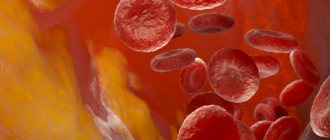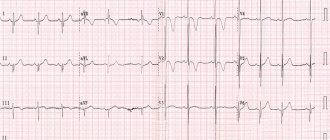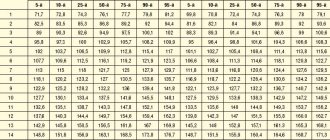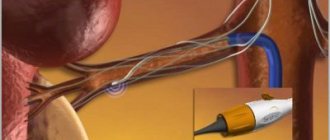Normal blood pressure in children
Normal blood pressure in children is very different from that in adults.
The values are influenced by the child’s age, which also determines the following parameters:
- the degree of elasticity of the walls of blood vessels;
- capillary mesh size;
- lumen in arteries and veins.
The younger the body, the better the condition of the circulatory system and the lower the blood pressure - blood moves freely through the vessels with minimal pressure on their walls.
The formation of blood pressure develops dynamically in the first 12 months after birth. During this period, it steadily increases by 1 mm Hg. Art. every 4 weeks. After a year the process of increase slows down.
Table “Normal blood pressure indicators in children under one year of age”
| Child's age | Reference blood pressure values (mmHg) | |
| Systolic | Diastolic | |
| First 2 weeks | 60–95 | 40–50 |
| 2 to 4 weeks | 80–110 | 40–73 |
| 4 to 8 weeks | 82–112 | 40–75 |
| From 8 weeks to 6 months | 85–115 | 50–70 |
| From 6 months to 1 year | 90–115 | 50–75 |
From birth to 5 years, the level of child pressure does not differ between girls and boys. From 6 to 9 years of age, blood pressure levels in males are slightly higher, and in adolescence they become slightly lower.
Table "Normal children's blood pressure by age"
| Number of years | Limit values of the norm (mm Hg. Art.) |
| From 1 to 2 years | 90–112/60–73 |
| From 2 to 4 years | 100–113/60–75 |
| From 4 to 6 years | 100–115/60–77 |
| From 6 to 8 years | 100–120/60–78 |
| From 8 to 10 years | 100–123/60–80 |
| From 10 to 12 years | 110–125/70–84 |
| From 12 to 16 years | 110–135/70–85 |
From 7 to 16 years the indicators gradually increase:
- in girls - by 1 mm Hg. Art.;
- in boys – by 1.5–2 mm Hg. Art.
Important! Due to the growth of the body, childhood activity and adolescence, large fluctuations in blood pressure are possible (20–25 mm Hg). If deviations greatly exceed acceptable limits, it is worth showing the child to a doctor.
Folk remedies
To raise lower pressure without raising upper pressure, many prefer to use folk remedies. To normalize indicators at home, use:
- Salt. You need to put a little salt on the tip of your tongue and suck it.
- Cinnamon. A quarter of a teaspoon is poured into a glass of boiling water, cooled, two tablespoons of honey are added and drunk on an empty stomach or a few hours before bedtime.
- Bread with honey and cinnamon. This sandwich will provide a slight increase in blood pressure.
- Infusions of lemongrass, eleutherococcus or ginseng take 30 drops, dissolving in a glass of warm water.
If the weather is hot, blood pressure drops due to increased sweating. In this case, a glass of cool water will improve your well-being.
Causes of pressure deviations from the norm
Blood pressure disorders can be a physiological feature of the body or occur against the background of external stimuli or internal diseases.
Why does my child have high blood pressure?
External causes can affect blood pressure and temporarily increase its levels:
- injuries;
- emotional overstrain or severe stress;
- physical fatigue.
If a child's blood pressure is consistently higher than normal, this may be a sign of moderate hypertension.
The development of pathological processes in a young body can provoke sharp and regular jumps.
- Cardiac pathologies - anomalies in the valve structure, congenital defects, poor conductivity of the heart muscle, rhythm disturbances.
- Kidney diseases (cause an increase in diastolic pressure) - dysplasia, structural defects, malignant compactions in tissues, injuries.
- Endocrine problems. Crohn's disease or tumor processes in the parathyroid glands disrupt tissue metabolism, which leads to excessive production of hormones and biologically active substances that narrow the lumen in the blood vessels and cause hypertension.
- Changes in the renal vessels of a congenital or acquired nature. Pathologies provoke secondary hypertension and act mainly on upper (systolic) blood pressure.
- Hereditary tendency to high blood pressure. This happens when one of the parents suffers from hypertension.
High blood pressure can be the result of long-term drug treatment with hormonal drugs and sympathomimetics. Blood pressure in adolescents is affected by alcohol consumption or smoking.
Why does my child have low blood pressure?
As the body ages, the pressure gradually increases. If a child experiences frequent downward swings, we may be talking about the development of serious diseases.
Provoking factors for hypotension are:
- disturbances in the endocrine system, which lead to a decrease in venous tone and loss of vascular elasticity;
- problems in hematopoiesis, in particular anemia;
- deviations in normal blood circulation that are caused by injuries or seals in the brain;
- decrease in thyroid hormones (thyroid dysfunction), which weakens vascular tone.
Low blood pressure can be a consequence of improper or inadequate nutrition, physical and emotional fatigue. In this case, low levels are temporary and return to normal after eliminating external stimuli.
First aid
The level of blood supply to organs and tissues is determined by the state of the diastolic indicator. But if the lower pressure is 50, this indicates serious violations and requires timely assistance from a specialist.
Due to malnutrition, pathologies of the nervous system develop, memory and concentration deteriorate, and the endocrine system and kidneys are affected.
If you feel a pronounced loss of strength, then to stabilize your condition you need to drink a cup of strong tea or coffee, or a little ginger tea. But these drinks cannot be consumed constantly, as they disrupt the processes of self-regulation of blood pressure.
Rubbing the muscles of the feet, legs, and kneading the hands has a reflexogenic effect on vascular tone.
First aid for a sharp decrease in blood pressure is to call an ambulance. Until the doctors arrive and the person is in a pre-fainting state, you need to do the following:
- lay him horizontally on his back;
- provide a flow of fresh air;
- free your neck and chest from tight clothing;
- give drops for hypotensive patients;
- rub the muscles on the legs, starting the massage from the ankles and up;
- if there is no suitable medicine, you can give strong coffee or 2 tablets of Citramon, since it contains caffeine.
Also, a way to normalize blood flow is to place the legs above the level of the head. To do this, tilt your legs over the back of the sofa. Proper first aid is very important. If you do everything correctly and in a timely manner, you can avoid loss of consciousness.
How to normalize blood pressure
Blood pressure should always be within age norms. If frequent jumps down or up are observed, specialists prescribe special treatment and adjust the child’s lifestyle.
Table “Methods of normalizing pressure”
| How to lower blood pressure | Follow the daily routine. Getting up in the morning and going to bed at night should be at the same time every day |
| Limit the consumption of pickled and canned foods. Reduce the daily dose of salt (food should be lightly salted) | |
| Improve your sleep. The need for a child’s body to sleep at night is at least 8–9 hours a day. Preschool children should be put to sleep during the day (1.5–3 hours) | |
| Treatment with antihypertensive drugs (diuretics, antispasmodics, calcium channel blockers, ACE inhibitors). Medicines are selected by the doctor individually, based on the underlying disease | |
| Avoid overwork. Physical activity should be moderate, and training should be dosed | |
| Maximum limitation of stress factors, emotional stress | |
| Spend more time outdoors | |
| In adolescence, avoid the abuse of weak alcoholic drinks and smoking | |
| How to increase blood pressure | Balance the diet so that the young body receives all the necessary substances. The child should eat more fruits, vegetables, meat, fish, dairy products, legumes and cereals. Meals must be divided into fractions (5–6 times a day) |
| To live an active lifestyle. Running, swimming, cycling, gymnastics, and dancing help increase low blood pressure. The main thing is to take into account the interests of the child | |
| Strengthen the body's defenses. Long walks in the fresh air (at least 40 minutes) and good nutrition will help with this. | |
| Use adaptogens (after consultation with your doctor). Tincture of lemongrass, ginseng or eleutherococcus increases the tone and elasticity of blood vessels | |
| Use physical therapy. A contrast shower and underwater massage help a lot. Normalization of pressure using similar methods occurs after 7–10 sessions | |
| Massotherapy. Conducted by a specialist. Restores normal functioning of the heart, blood vessels and nervous system, stabilizes blood pressure |
Preventive measures and specific therapy help restore normal functioning of the heart and blood vessels, strengthen the defenses of the young body and improve the general condition of the child. The main thing is to first examine and identify the causes of deviations, and then begin treatment.
Diagnostic methods
To determine the reasons for the decrease in diastolic pressure, you need to visit a doctor. After research has been carried out and the etiology of the disorder has been established, therapy is carried out. For diagnostic purposes, the following is carried out:
- Echocardiography;
- electrocardiogram;
- blood biochemistry;
- Magnetic resonance imaging.
Echocardiogram electrocardiogram blood biochemistry magnetic resonance imaging
If abnormalities in the functioning of the endocrine system are suspected, the following is additionally required:
- hormone tests;
- Ultrasound examination of the thyroid gland.
A general blood test is required. The doctor selects methods to increase lower pressure without increasing upper pressure.
How to measure a child's blood pressure
Measuring blood pressure in children has its own characteristics and is slightly different from a similar procedure in an adult.
- It is recommended to carry out the procedure in the morning, an hour after eating or walking. The child must visit the toilet and not be exposed to stress.
- The first time you take a measurement, you need to use both hands to determine where the pressure is higher.
- For a child under 2 years of age, the procedure is carried out in a lying position, for children older than this age - sitting, the legs should not hang down (if the baby does not reach the floor, install a stand).
- To measure, use a cuff according to size, since the component part of the tonometer for adults can distort the results of the study. For accurate measurement, the cuff should be ¾ of the distance from the armpit to the bend of the elbow.
Further, the procedure is no different from the usual sequence in adults. A phonendoscope is applied to the vein in the elbow, air is pumped in with a bulb and, after deflating the air, the beginning (systolic pressure) and end of the pulsation (diastolic blood pressure) are noted.
Blood pressure in children is always lower than in adults. The younger the body, the higher the elasticity of the vessels and the wider their lumen, which means that the pressure of blood on the lining of the arteries is minimal. As the child grows up, blood pressure gradually increases and by the end of adolescence reaches stable levels (110–120/70–80). Blood pressure in childhood can be affected by external factors - stress, overwork, trauma, physical activity, or internal diseases - cardiac, endocrine, renal pathologies.
Diagnostic measures
To raise your lower blood pressure at the first signs of disturbances, you need to visit a cardiologist or neurologist. The examination is carried out to identify the underlying cause of the disease. The condition and functioning of the heart is assessed using electrocardiography, echocardiography, magnetic resonance imaging, and biochemical blood tests.
To identify pathologies of the thyroid gland and hormonal imbalances, they donate blood for hormones and conduct an ultrasound examination.
Using a general blood test, anemia and inflammatory diseases that can cause diastolic hypotension are determined. After receiving the research results, suitable treatment is selected.
Lifestyle and diet
You can achieve normalization of blood pressure through proper nutrition and lifestyle. First of all, you should adjust your diet:
- eat more vegetables, fruits, dried fruits, nuts, sea fish, legumes, fresh cranberries;
- eat about five times a day in small portions;
- use decoctions of rose hips, pomegranate juice, and hawthorn tincture.
There are recipes for increasing blood pressure using alcoholic beverages, but they must be treated with extreme caution.
Lower pressure indicates the condition of the kidneys, cardiovascular and endocrine systems. If this indicator is reduced, a set of therapeutic measures is necessary. If there is a slight deviation from the norm, you can get rid of the problem using:
- If you feel unwell, you should drink tea and coffee, and eat chocolate. Drinks containing caffeine are contraindicated; they cause tachycardia, so they should not be abused.
- Every morning do exercises or do some kind of sport.
- Do not overwork, find time to rest throughout the day, and avoid emotional stress.
- Take a contrast shower and pierce the body.
- Get rid of bad habits. Smoking and alcohol are prohibited, even if your health has improved.
If these measures have no effect, you need to visit a doctor and undergo an examination, since the problem may be a serious pathology.










